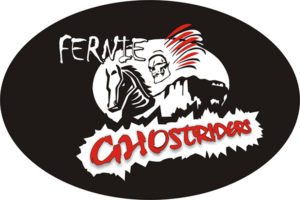Home »

KIJHL clubs talk about how pandemic impacted recruiting
By Emanuel Sequeira
It was an unusual off-season for Kootenay International Junior Hockey League (KIJHL) teams because of the COVID-19 pandemic. They weren’t able to hold spring camps and showcases were delayed. This impacted the way they scouted and recruited for an unknown 2020-21 season.
Most took the approach of wanting to be ready even if they didn’t know a season was happening.
 The Fernie Ghostriders had a list of scouted and targeted players from the previous season, plus they relied on video provided by players and coaches.
The Fernie Ghostriders had a list of scouted and targeted players from the previous season, plus they relied on video provided by players and coaches.
“Using our network of scouts and trusted hockey people throughout Western Canada also assisted in the process,” said coach-GM Jeff Wagner. “We feel good about the relationships we have with coaches and scouts throughout Western Canada, so networking was the biggest resource. Recruiting was more of a collaborative effort than we’ve seen in the past, but given the challenges – it was a fairly smooth process.”
The speed bumps, besides not being able to see players perform in person, were primarily financial.
“In the 11th hour of planning for the season, we had to adjust our budget drastically, which had financial implications on both returning and recruited players,” he said. “It felt like we almost had to re-recruit players and we did lose a handful due to the reality of what we were working with.”
Dean McAmmond, coach of the North Okanagan Knights, says they focused on homegrown talent.
“There may be a few stronger players if you go searching further up the tree, but there are some good ones that are not hard to reach,” he said. “The best of the low lying fruit I guess you could say.”
Looking at their roster, only two rookies this season are from outside B.C.
Grand Forks Border Bruins coach-GM John Clewlow says there were challenges, but added each team had the same problems.
“There were a little more phone calls to players and coaches,” he said. “The world continues to advance technologically speaking, so using all the devices we have at our disposal is the best way to adapt to recruit without having the ability to see players in person or on the ice.”
The Nelson Leafs used video, especially HockeyTV to watch players during the spring and summer. Assistant coach and assistant GM Adam DiBella said this is probably the only off-season that almost all of the recruiting was done from a desk.
“We had tabs on some players and also utilized the connections we had with other teams and leagues,” said DiBella. “What it came down to was just picking up the phone and keeping in close contact with coaches and players. We always felt like that with the leadership of our league and BC Hockey, that we would have a season one way or another, and we recruited that way.”
“Now you rely on your scouting personnel and word of mouth through a lot of research,” said Chase Heat coach Brad Fox, who had many phone conversations about recruits, with recruits and their families on what the Heat’s expectations are. “So much of our focus comes from who they are as an individual in their character make up. That takes a lot of research and time in learning about them when you cannot see them face-to-face.”
The Heat adapted by communicating and trusting the instincts as a staff.
In Kelowna, Chiefs coach Ken Law says it took convincing players there would be a season and that they would handle the proper safety protocols.
“We knew going into the recruiting process one area we would need to address was billet homes as not everyone would be comfortable in opening their homes to strangers during these strange times,” said Law. “I became an online recruiter more than ever and learned lots about Zoom and Facetime.”
The Chiefs identified players early during the season and stayed in contact after the season.
Entering his first full season as Golden Rockets coach-GM, Chuck Wight says it was coming into another change of routine.
“You’ve got the network that had to get started, couldn’t really get started,” he said. “We had to try some different options. We looked at some different opportunities and it’s just always video. You work the phone based on that. I know a lot of higher end programs will go the video route first. They have had success with that. You know what you have from a talent point of view. Then you have to get to know the athlete and understand their family dynamic. That was the biggest challenge. Meeting people in parking lots. It’s a different world right now.”
Wight also felt the players needed to showcase themselves and make video more accessible. He experienced challenges tracking players down, especially because he couldn’t get to rinks. Once development camps were able to be held, that created the bigger issue from junior A programs. There was an unknown of when they would release players. He made the decision to build the Rockets with players that want to be there.
Osoyoos Coyotes head coach Carter Rigby leaned on contacts, among them Coyotes hockey consultant/assistant coach John DePourcq, who coached the south zone team last season. He has a few of DePourcq’s players on his roster. There were challenges related to cost, causing some players to not play.
Ryan Parent, coach-GM of the Revelstoke Grizzlies, faced his own obstacles with some players choosing school this year over hockey.
 It was difficult for Derek Stuart, coach-GM of the Kimberley Dynamiters, to recruit because of the unknowns. He didn’t know how many veterans would come back or were quitting. This created a situation in which he didn’t know how many holes he needed to fill.
It was difficult for Derek Stuart, coach-GM of the Kimberley Dynamiters, to recruit because of the unknowns. He didn’t know how many veterans would come back or were quitting. This created a situation in which he didn’t know how many holes he needed to fill.
“With so many veterans and midget recruited players still in junior A, we won’t know what our regular season team will look like until early December,” Stuart said in September.
The pandemic eliminating camps and the uncertainty of them made it hard to sign players in the summer.
“We don’t like to sign guys unless we know they are coming here for sure,” he said.
The Princeton Posse have always relied on their camps and other showcases to learn about recruits. This year, they used game film and tried to connect through other coaches and a scouting network to find the right pieces.
“The biggest challenge was losing both recruits and returning players because we had no real answers for them for so long,” said Posse coach-GM Mark McNaughton. “Players and their families had to make decisions and when we didn’t have answers on how the league would operate in time, they had to make other choices.”
Getting into the Summerland Steam coach-GM position in April made things interesting for Nick Deschenes. Because he didn’t see midget or junior hockey the previous season, Deschenes felt he lost recruiting battles.
“In the off-season, lots of time was spent watching video from the previous season,” he said. “I also made a point of attending every showcase possible to get a sense of the players available. Stats can be deceptive and being able to see a player live is very valuable.”
Deschenes had to watch each player to get a true sense of their play.
“Having coached over the years, you start to find certain things that either qualify or disqualify a player quickly,” he explains. “Then from there you take a closer look at the potential candidates. It’s also important to give players more than one opportunity to showcase themselves. We all have bad days.”
Emanuel Sequeira is KIJHL Director of Communications







